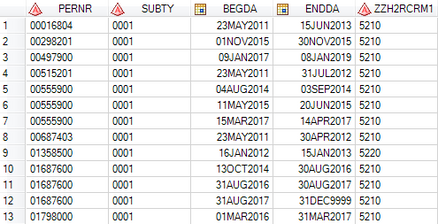- Home
- /
- Programming
- /
- Enterprise Guide
- /
- How to turn consecutive dates in one period?
- RSS Feed
- Mark Topic as New
- Mark Topic as Read
- Float this Topic for Current User
- Bookmark
- Subscribe
- Mute
- Printer Friendly Page
- Mark as New
- Bookmark
- Subscribe
- Mute
- RSS Feed
- Permalink
- Report Inappropriate Content
Above is an extract of the data I need to work with.
When the same PERNR has consecutive periods with the same ZH2RCRM1 code, I want all that information in just 1 line.
For example PERNR 01687600 has 3 consecutive periods with the same ZH2RCRM1 code (5210).
What I want is to turn those 3 records into one:
01687600 0001 13OCT2014 31DEC9999 5210
I just started in SAS so I have no idea of doing this.
Thanks in advance!
- Mark as New
- Bookmark
- Subscribe
- Mute
- RSS Feed
- Permalink
- Report Inappropriate Content
You do have one more decision to make ... how to treat SUBTY. In your sample data, it is constant. But what if it were to change? What value should be used? Should different values signal different groupings? At any rate, here is one approach that assumes your data is sorted as indicated in your sample data. It also assumes your date variables are actual SAS date values (not character strings ... a PROC CONTENTS will reveal that much):
proc summary data=have;
var begda endda;
id subty;
by pernr zzh2rcrm1 notsorted;
output out=want (drop=_type_) max(endda) = endda min(begda) = begda;
run;
This program also adds a variable named _FREQ_ that indicates how many observations were collapsed in order to form the resulting observation. If you don't want that in the output, add it to the drop list:
(drop = _type_ _freq_)
- Mark as New
- Bookmark
- Subscribe
- Mute
- RSS Feed
- Permalink
- Report Inappropriate Content
Thank you very much for your reply. It helped a lot!
For the SUBTY variable: it remains constant throughout the whole dataset
The date variables are indeed SAS date values.
Just one more thing. I noticed that I also have PERNRs who have some dates that are consecutive than a 'standalone' period and then again some consecutive dates as you can see in the picture above (PERNR 09625800)
For that PERNR my output should be:
09625800 0001 01JUN2012 31OCT2012 5210
09625800 0001 17JUN2013 31OCT2013 5210
09625800 0001 01JUL2014 30SEP2014 5210
09625800 0001 01JUL2015 24JAN2016 5210
instead of:
09625800 0001 01JUN2012 24JAN2016 5210
In general: I can't 'lose' any dates in my output 😉
Sorry if it wasn't very clear
- Mark as New
- Bookmark
- Subscribe
- Mute
- RSS Feed
- Permalink
- Report Inappropriate Content
For that situation, you will need to construct your own grouping variable before running PROC SUMMARY. For example:
data temp;
set have;
by pernr zzh2rcrm1 notsorted;
prior_end = lag(endda);
if first.zzh2crm1 or begda ne prior_end + 1 then group + 1;
drop prior_end;
run;
proc summary data=temp;
var begda endda;
id subty;
by pernr zzh2rcrm1 group notsorted;
output out=want (drop=_type_ group) max(endda) = endda min(begda) = begda;
run;
- Mark as New
- Bookmark
- Subscribe
- Mute
- RSS Feed
- Permalink
- Report Inappropriate Content
This is exactly what I wanted!
Thanks again!
April 27 – 30 | Gaylord Texan | Grapevine, Texas
Registration is open
Walk in ready to learn. Walk out ready to deliver. This is the data and AI conference you can't afford to miss.
Register now and lock in 2025 pricing—just $495!
Check out this tutorial series to learn how to build your own steps in SAS Studio.
Find more tutorials on the SAS Users YouTube channel.
SAS Training: Just a Click Away
Ready to level-up your skills? Choose your own adventure.



